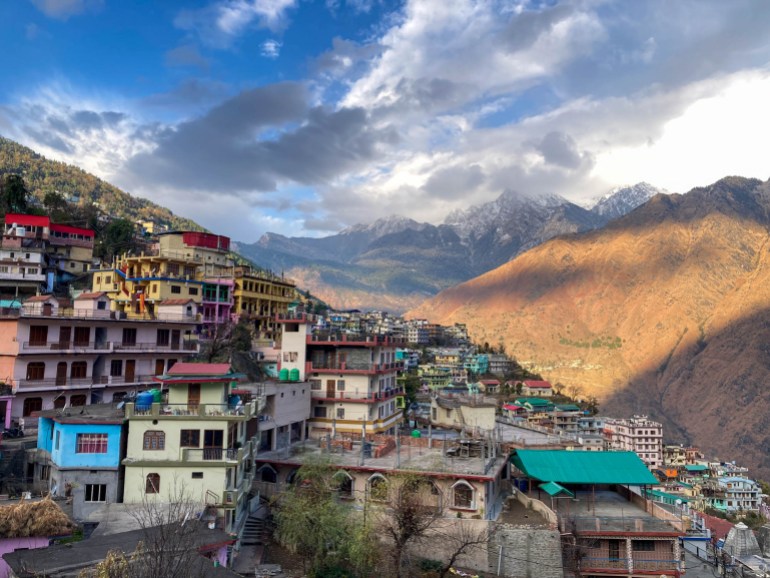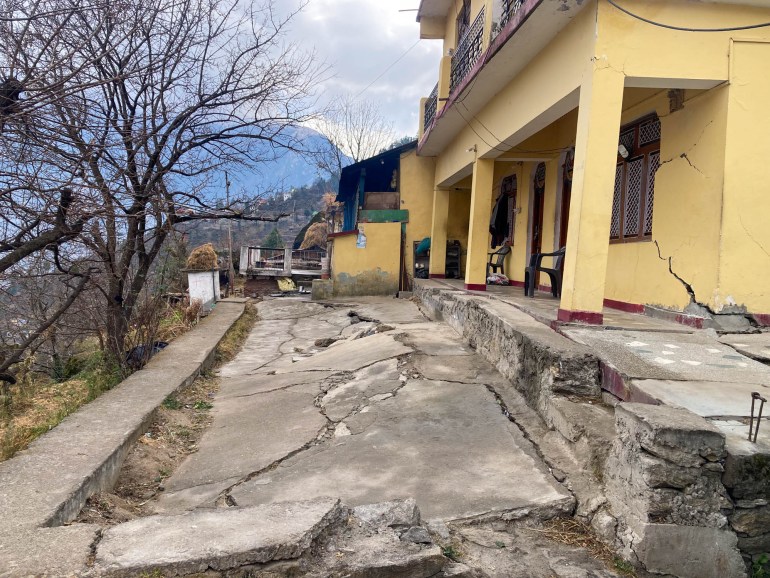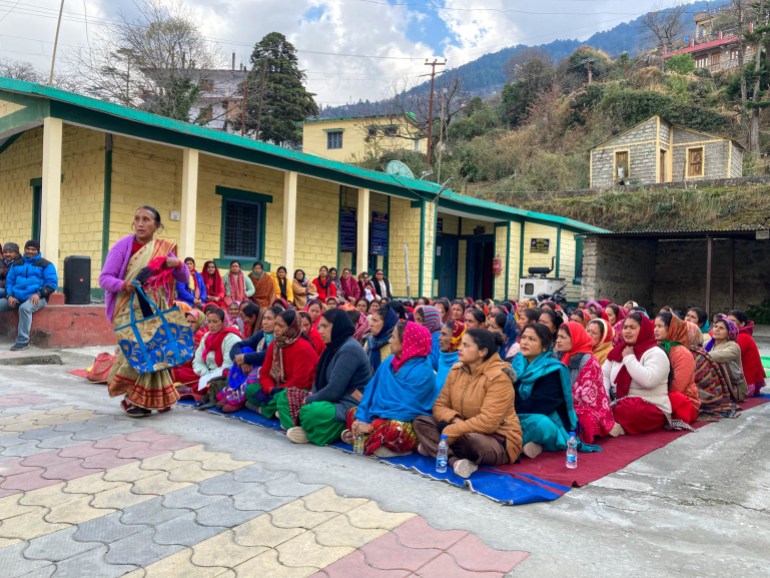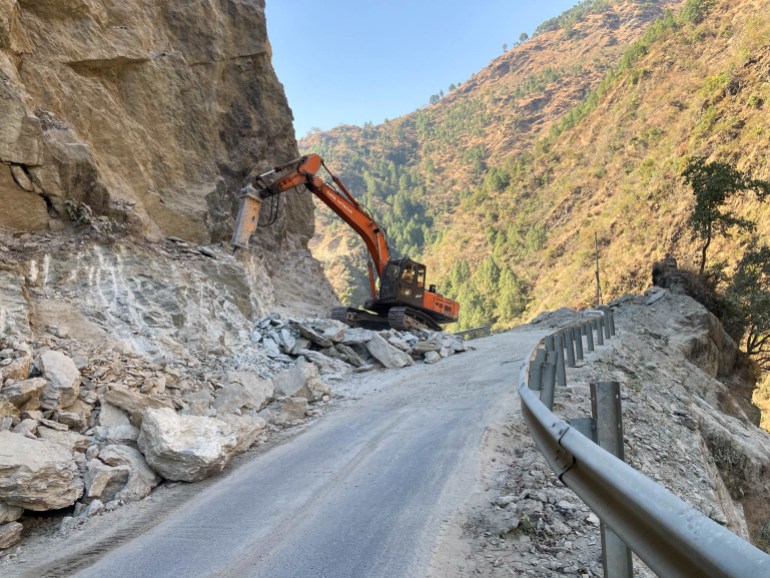Month later, rehabilitation eludes residents in India’s Joshimath
As houses and roads began to crack, about 240 families were temporarily relocated and many others fled the Himalayan town out of fear.

Joshimath, India – It was 3.40am on January 3 when Digambar Singh Bisht woke up hearing a loud rumble. “It felt like the ground beneath us would crack open,” he told Al Jazeera.
The house shook and the glass windowpanes of two nearby hotels got shattered. The family of five rushed out in fear. “We spent the night on the road,” the 41-year-old said.
Keep reading
list of 3 itemsDemolitions begin in India’s ‘sinking’ Joshimath, hundreds moved
Sinking Himalayan town puts spotlight on India’s hydropower push
In the morning, Bisht returned to a house that was severely damaged with wide cracks on the walls and the floor. It had become unliveable. Cracks were also visible on some patches of the town’s roads.
Bisht lives in Joshimath, a Himalayan town close to the India-China border in Chamoli district of India’s northern state of Uttarakhand.

As panic set in and the protests became shriller, the local administration moved the Bisht family to a room in the Joshimath municipality building.
Several families whose houses were damaged, including the Bishts, have been residing in the building for more than a month now. “We were told that this relocation is temporary and the government will provide us proper compensation and rehabilitation. But we haven’t yet heard anything from the government,” Bisht told Al Jazeera, adding that his family has received a compensation of only 150,000 rupees ($1,820).
Officials say parts of the town are sinking. Bisht’s house is among 860-odd “unsafe” buildings where cracks have been identified so far. The government has declared Joshimath a disaster-hit “landslide” and a “land subsidence” zone.
At least 240 families have been temporarily relocated. Many have left the town out of fear. “There are no tourists here after the disaster,” said Ajay Sharma, who drives a taxi.
Authorities have been carrying out “controlled mechanical demolition” of a few buildings. These include a government guesthouse, hotels, and houses.

Months of red flags
Perched between 5,249 feet and 6,889 feet, Joshimath is a fast-growing town of about 23,000 residents. It is a gateway to Badrinath and Hemkund Sahib, visited by millions of Hindu and Sikh devotees respectively every year.
Tourists hiking to the Valley of Flowers, a UNESCO World Heritage Site, and skiers headed to Auli, a short drive away, often halt at Joshimath.
On January 3, like Bisht, several residents in the town heard the rumble, vibrations, or the sound of water gurgle underneath the ground. A government official, on condition of anonymity, said a few Indian Army personnel also informed the survey teams about it.
Joshimath is home to an Indian Army base. It also houses facilities for the Indo-Tibetan Border Police, deployed on the India-China border.
“We are not sure of what happened on January 3,” Ranjit Kumar Sinha, Disaster Management Secretary in the Uttarakhand government, told Al Jazeera. “It is a mystery so far.”
A report by the National Remote Sensing Centre (NRSC) of the Indian Space Research Organisation (ISRO) said land in the town rapidly sunk by 5.4cm (2.1 inches) between December 27, 2022 and January 8 this year.
It further said that between April and November 2022, the land had sunk by 8.9cm (3.5 inches). The report led to a gag order by the government, prohibiting 12 government agencies from discussing the Joshimath issue with the media. Soon after the gag order, the Joshimath report vanished from the NRSC website.

But other reports confirm surface displacement in Joshimath over the past few years.
Navin Juyal, a geologist currently studying the cause of sinking land and damaged houses in Joshimath, says the town reached a “tipping point” on January 3.
More than 500 litres of turbid water started gushing out every minute from an underground channel in the Marwari area, and damage to several houses was sudden and severe, he pointed out.
“Joshimath slopes are currently experiencing a vertical subsidence, which is causing land to sink, and a horizontal creep, which is a slow downward movement of soil and debris,” Juyal told Al Jazeera.
At least 14 families in the town’s Chhawani Bazar area first noted cracks in their houses in October 2021. With time, the cracks got wider and deeper, and appeared in hundreds of houses across the town. In several houses, the beams got dislodged.
Rajendra Lal, a 60-year-old former Indian Army soldier whose house was completely damaged by the end of 2022, says, “Every few days, I have to argue with the local administration to finalise my compensation and rehabilitation before they demolish my house.”
“I have been asking them [officials] about what their plans are for people like me, but I haven’t received an answer yet,” Lal adds.
Nearly 190 prefabricated huts for affected families have been proposed for construction at Dhak village, about 11km (7 miles) from Joshimath, says Sinha, adding that 15 huts are currently under construction.

Government reports question rampant construction
A September 2022 report by the Uttarakhand State Disaster Management Authority (USDMA) blamed rampant construction in Joshimath and inadequate wastewater disposal and drainage systems for the sinking land.
“The town is built on the debris of an old landslide and cannot bear the burden of rampant construction,” Piyoosh Rautela, executive director of Uttarakhand’s Disaster Mitigation and Management Centre (DMMC), told Al Jazeera.
Only 10-15 percent of the buildings currently have sewerage connections, while the remaining use soak pits.
“Water from the soak pits enters the ground and pushes down fine sediments, which leads to land subsidence,” Yaspal Sundriyal, a geologist from the Hemvati Nandan Bahuguna (HNB) Garhwal University in the state’s Srinagar town, told Al Jazeera.
These issues were also pointed out in a 1976 report by the MC Mishra Committee, which was the first administrative report elaborating the causes behind land subsidence in Joshimath, Himalayan historian Shekhar Pathak told Al Jazeera.

Joshimath is in Zone V, the highest-risk zone on the seismic map. The Mishra Committee report had warned against developing Joshimath into a township. It also said the “vibrations produced by blasting and heavy traffic” will worsen the pre-existent geological challenges.
But nobody paid heed to the warnings. “Unscientific constructions and poor governance have forced Joshimath to become a sinking town,” Sundriyal said.
Locals blame road and dam construction
“Go back NTPC” signs can be spotted across Joshimath, as angry residents blame an under-construction hydropower project by the state-owned corporation for their woes.
Once built, the Tapovan Vishnugad hydropower project will produce about 520MW of electricity. But it has been in the eye of the storm several times since 2006.
In December 2009, an aquifer punctured during the construction of the project’s tunnel. It resulted in a daily discharge of about 60-70 million litres of water that would sustain about two to three million people.
“Over a decade of water discharge from the aquifer puncture has resulted in the land sinking,” says Atul Sati of the Joshimath Bachao Sangharsh Samiti that is leading the ongoing protests for compensation and rehabilitation of the families.
NTPC has denied its project has any role to play in land subsidence.
Besides the hydropower project, a section of the residents and experts also blame the use of explosives for the under-construction 6km (3.7 miles) Helang-Marwari bypass road, part of the ambitious 825km (512.6 miles) Char Dham road project.
The project will allow faster deployment of troops to the Indo-China border and improve access to the Hindu religious sites of Badrinath, Kedarnath, Gangotri, Yamunotri and Kailash Mansarovar.
“The use of explosives and drilling for the bypass has contributed to destabilising Joshimath’s foundations,” said Sundriyal, the geologist.
In an attempt to control the situation and to cool down the tempers, on January 5, the local administration gave orders to temporarily stop construction of the NTPC project and the bypass.
But locals say it is too little, too late. “The NTPC must permanently stop work on the Tapovan Vishnugad project and acknowledge their role in the making of this disaster,” Sati said.
Nearly 150 organisations, experts, environmentalists and citizens, mainly from the Himalayan region, have supported Sati’s argument by issuing a statement this week, showing solidarity with Joshimath’s “ongoing struggle for justice and accountability”.
While the government has declared Joshimath a disaster-hit town, the statement argues the Joshimath disaster is “not natural”, and is largely a result of projects like dams and highways that are being built in the name of “national interest” and “development”.
Himalayan dams worsening climate crisis
Hydropower projects are a contentious issue across the Himalayan region. Such projects continue to be built with inadequate environmental and strategic impact assessments, and without policy compliance – issues which, for instance, are also true for the Nepal Himalayas, said Ajaya Dixit, a water specialist from Nepal who is a senior adviser at the Institute for Social and Environmental Transition-Nepal.
Uttarakhand is key to India’s focus on hydropower. The government estimates that the state has a potential for small hydropower plants with 1,664MW capacity, and large hydropower projects of 17,998MW. The current installed capacity stands at 219MW from small hydro projects and 3,975MW from large ones.
Such projects were blamed for exacerbating the effects of the 2013 floods in Uttarakhand which killed thousands. In the 2021 floods in Chamoli district, of the more than 200 deaths, 192 happened at the sites of two hydropower projects – 13.2MW Rishiganga, and NTPC’s Tapovan Vishnugad – leading to demands of scrapping such projects.
The government said the plants were being allowed to continue since more than 50 percent of the work had already happened.

Various reports of the Intergovernmental Panel on Climate Change (IPCC), a United Nations body, say that the Himalayan region, which extends over India, Tibet, Nepal, Bhutan, Myanmar, Bangladesh, Pakistan, and Afghanistan, is at risk of floods and landslides from increased instances of heavy rainfall due to climate change. Also, Himalayan glaciers are fast melting due to global warming, the reports say.
In Uttarakhand, which lies in the central Himalayas, floods and landslides have caused thousands of deaths over the past decade. Some of these instances have been linked to climate change. According to Uttarakhand DMMC, 7,750 cloudbursts and extreme rain instances, and 1,961 landslides were recorded in the region between 2015 and mid-2021.
Anjal Prakash, an IPCC author who studies climate change in areas including the Himalayas, and is currently at the Hyderabad-based Indian School of Business, told Al Jazeera, “Large hydropower projects in the Himalayas will worsen the impacts of floods and landslides from climate change.”
For Joshimath, the 2022 USDMA report mentions three instances as being crucial to its current situation – the June 2013 Uttarakhand floods, February 2021 Chamoli floods, and the very heavy rains of October 18-19, 2021 (measuring up to 190mm or 7.5 inches).
Cycle of displacement
Sinha says the government is in the process of preparing a comprehensive package for the affected families, which will be presented during an Uttarakhand cabinet meeting scheduled for February 15.
“We will keep all options open for the residents, whether they want money, or a house built,” he told Al Jazeera, adding that the government is also scouting for land in nearby towns.
Various agencies have submitted reports on Joshimath to India’s National Disaster Management Authority (NDMA). Sinha says the findings are being collated by the NDMA. Once finalised, they will be presented to the Uttarakhand government.
“On February 15, we shall present a draft policy for Joshimath in front of the Uttarakhand cabinet. However, the specifics of rehabilitation will be decided after we receive NDMA’s final report,” he said.
However, residents say their lives are in limbo as they continue to protest for better compensation.
Akhilesh Kumar Katiyar, 54, had moved to Joshimath from Chaien village – about 13km (8 miles) away – in 2008, after a leaking tunnel from a hydropower project damaged his home.
A survey by authorities marked his Joshimath residence in the “red zone” on January 17. Since then, the family of five has been living in a hotel room. “Now, even the house in Chunar [in Joshimath] has become unliveable because of sinking land. We don’t know what the future holds for us,” Katiyar told Al Jazeera.
In his one-room accommodation at the municipality office, Bisht is angry about the lack of information.
“We have no idea if this town will survive,” he says. “So many government agencies are here. But we don’t know what they are up to since the government has gagged them.”